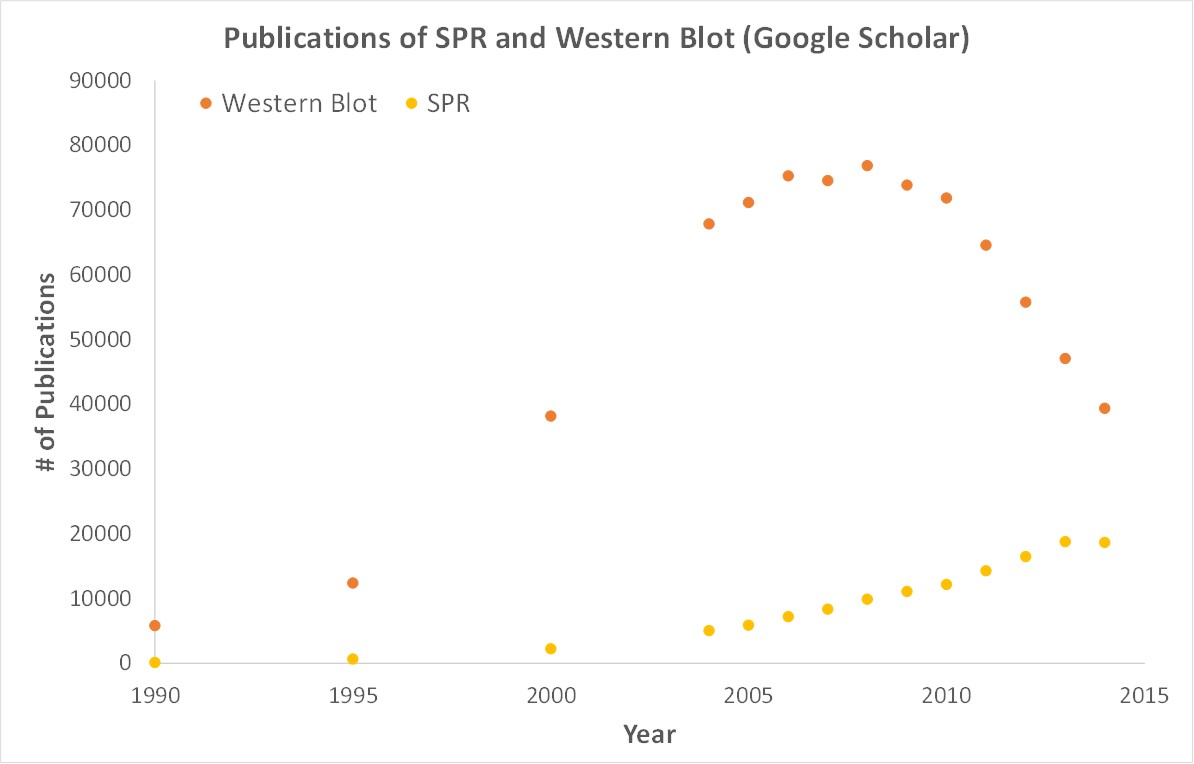Malignant carcinomas, namely cervical, is the second most common malignancy with an exceptionally high mortality rate among women. The Janus kinase/signal transducers and activators of transcription (JAK/Stat) signaling pathway is a notorious pathway in the development of cervical cancer and when JAK/Stat signals are sent in an excessive and irresponsible manner, cells can begin to divide uncontrollably.
In this new publication, Dr. Dongdong Zhang and Dr. Yanmin Zhang use OpenSPR’s localized surface plasmon resonance technology to provide them with the key binding data needed for their discovery. The publication “Compounds TAD-1822-7-F2 and F5 inhibited HeLa cells growth through the JAK/Stat signaling pathway” uses binding data generated with OpenSPR to demonstrate the disruption potential of small molecules synthesized from taspine-derivatives to target Janus Kinase 2 (JAK2) that will, in turn, combat excessive JAK/Stat signaling.
About the Publication
The JAK/Stat pathway is responsible for a number of normal cellular functions through a series of protein interactions starting outside of the cell, to the nucleus. This pathway is the primary signaling pathway for cell proliferation, differentiation, cell migration and apoptosis. Unfortunately, overactivation of the JAK/Stat signaling may lead to a whole host of diseases and disorders, including cervical cancer. A major player of this pathway is the ~130 kDa Janus Kinase 2 (JAK2) which is a non-receptor tyrosine kinase and has become a common inhibitory target. In this publication, the researchers synthesized novel small molecules from taspine derivatives; these novel compounds, F2 and F5, maintain molecular weights of ~530 Da and were suspected to behave as strong inhibitors in HeLa cell proliferation by acting on JAK2 in the JAK/Stat pathway. Results from the study concluded that both F2 and F5 can effectively bind JAK2 and further suggests that F2 was the better candidate. The binding between F2 and F5 to JAK2 was studied using surface plasmon resonance.
Why was OpenSPR instrumental for this research?
Surface plasmon resonance was used to determine the binding between two different taspine-derived small molecules, F2 and F5 (~530 Da) and the 130 kDa nonreceptor tyrosine kinase Janus kinase 2 (JAK2). His-tagged JAK2 was immobilized on Nicoya’s NTA sensor chip and the protein-small molecule experiment was run on the OpenSPR system. By using OpenSPR, the researchers were able to determine the kinetic data (association and dissociation rate constants, equilibrium constant and affinity) of the interaction between the novel compounds and their target protein, JAK2. F2 and F5 were shown to effectively target JAK2 and thus, suppress phosphorylation of downstream Jaks and Stats. This successfully inhibited HeLa cell proliferation. The quantitative binding data exhibit equilibrium dissociation constants (KD) of F2 and F5 was found to be on the order of 6.05×10-8 M and 4.67×10-7, respectively (Figure 2, A and B). This data indicates that the candidate compounds possess a high affinity for JAK2 and heavily contributes to inhibition of HeLa cell proliferation. The results from this study confirm that JAK2 may act as an appropriate target for these novel compounds through regulation of the JAK/Stat pathway, a notorious pathway in the development of cervical carcinoma. In conclusion, OpenSPR provided proof-of-concept binding kinetics data for the use of two novel, taspine-derived small molecules to suppress HeLa cell proliferation and contribute to the fight against cervical cancer. With OpenSPR, the researchers were able to get SPR data from their own bench, helped them accelerate their research and publish their discovery faster.
Why is SPR critical for publications? How does OpenSPR help?
SPR is a label-free technology which allows researchers to quantitatively analyze binding between two biomolecules. SPR technology allows us to determine the kon, koff and KD of interactions, providing deeper insight into binding events compared to other techniques that only give endpoint measurements, such as pull-down assays. SPR is necessary not only for publications but for the advancement of many fields of medicine and medical research as can be seen below with the significant increase in publications that rely on SPR data.

Scientific publications involving SPR have increased drastically over the years. SPR has become fundamental for publications while traditional techniques like Western Blots are becoming less important.
OpenSPR is a user-friendly and low maintenance benchtop SPR solution that is currently being used by hundreds of researchers. With access to SPR technology on your own lab bench you can get the high quality data you need to accelerate your research and publish faster.
